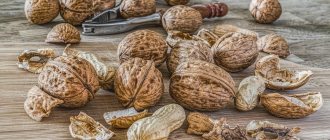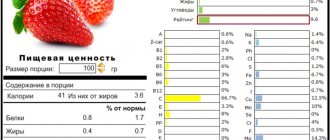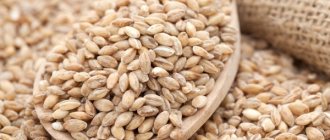It is assumed that the birthplace of peanuts is South and Central America, where this nut has been growing since time immemorial. By the way, it played a key role in the diet of the Aztecs and other local tribes. But thanks to Spanish and Portuguese explorers, these nuts spread throughout the world. Today this plant is grown in China, India, African countries, and the USA. There are many varieties of peanuts, but the varieties most often found in markets are Virginia, Valencia, Spanish, and Runner.
Walnut or not?
Biologists call this type of plant Arachis hypogea (but not araxis, as is sometimes mistakenly written), but in everyday life people gave it another, more understandable, although not entirely correct name - groundnut. Why wrong? Scientifically speaking, peanuts are not nuts. It actually belongs to the legume family, but has all the qualities of almonds, pistachios and other nuts.
Content:
- Walnut or not?
- Nutritional Components of Peanuts
- Antioxidants in nuts: benefits and harms
- How to choose the right fruits
- Nut processing methods
- Peanuts for weight loss
- Beneficial properties for the body
- Side effects
From the day of sowing to fruiting it usually takes 120-150 days. As the stems grow, pods form and hang to the ground. When kernels begin to form, the pods slowly make their way underground and the final formation of nuts occurs in the soil. To harvest, plants are dug out of the ground. Each bush can produce from 10 to 150 pods with fruits. The rough, wrinkled pods somewhat resemble beans, and the nut itself is divided into two equal parts, like the fruits of legumes. So, having studied the appearance, the answer to the question of what peanuts are: a nut or a legume becomes obvious.
In the homeland of peanuts, they are rarely eaten raw, but are more often eaten fried, salted, or in the form of peanut butter. In addition, flour and protein shakes are made from ground nuts, and the nut itself is used to make desserts, confectionery, baked goods, sauces, and salty snacks. After all, not only do groundnuts have a good taste, they are also rich in proteins, fats and many useful nutritional components. Research shows that peanuts may be beneficial for weight loss and also reduce the risk of heart disease [1].
Who called peanuts groundnuts and how?
The botanical name of this legume is Arachis hypogea. But people called it “peanut”. And not only the residents of Russia were so deeply mistaken. This phrase appeared in our speech as a borrowed phrase. That is, the delusion went far beyond the boundaries of one country and turned out to be international.
The fact is that this is not a nut at all, but an annual herb, the final formation of the fruits of which occurs in the soil. The maturation process usually lasts from 4 to 5 months. The stems tend to rise, and the pods first hang down and then gradually make their way underground. During harvest, they literally have to be dug up. This is how the first part of the common name appeared.
The wrinkled pods and the fruits themselves are in many ways similar to beans. But it was confused with a “nut” because it has all the properties that characterize hazelnuts, pistachios and other fruits consisting of a shell and an edible kernel.
Nutritional Components of Peanuts
Nutritional value (per 100 g of product) [2]
| Calories | 567 Kcal |
| Squirrels | 25.8 g |
| Carbohydrates | 16.1 g |
| Fats | 49.2 g |
| Cellulose | 8.5 g |
| Monounsaturated fats | 24.43 g |
| Polyunsaturated fats | 15.56 g |
| Omega-6 | 15.56 g |
| Vitamin E | 8.33 mg |
| Vitamin B1 (thiamine) | 0.64 mg |
| Vitamin B2 (riboflavin) | 0.14 mg |
| Vitamin B3 (niacin) | 12.07 mg |
| Vitamin B5 | 1.77 mg |
| Vitamin B6 (pyridoxine) | 0.35 mg |
| Folic acid | 240 mcg |
| Kholin | 52.5 mg |
| Calcium | 92 mg |
| Iron | 4.58 mg |
| Magnesium | 168 mg |
| Phosphorus | 376 mg |
| Potassium | 705 mg |
| Sodium | 18 mg |
| Zinc | 3.27 mg |
| Copper | 1.14 mg |
| Manganese | 1.93 mg |
| Selenium | 7.2 mcg |
Squirrels
Almost 30% of peanuts are proteins. Thanks to this, groundnuts belong to the most nutritious foods. However, excessive consumption of these beans can cause allergies in some people.
Fats
Peanuts are a high fat food. For this reason, the nut is classified as an oilseed crop and is used to make peanut butter. The percentage of fat in groundnuts is about 44-56 points, but mainly these are healthy mono- and polyunsaturated lipids.
Carbohydrates
But there are few carbohydrates in the product - only 13-16% of weight. Low carbohydrate content and high concentration of proteins, fats and fiber provide a low glycemic index. Consequently, after consuming the product, the level of glucose in the bloodstream increases gradually, rather than in spurts. This quality makes peanuts a suitable food for diabetics.
Vitamins and minerals
You still need to look for another product so rich in vitamins and minerals - peanuts contain almost all the nutrients necessary for health:
- biotin (important for pregnant women);
- copper (good for the heart);
- niacin (supports the heart and blood vessels);
- folic acid (extremely important for pregnant women);
- vitamin E (antioxidant);
- vitamin B1 (supports the performance of the heart, muscles, and nervous system);
- phosphorus (important for growth and proper development of tissues);
- magnesium (protects against cardiac diseases).
Properties of peanuts for losing weight
The product has a composition that ensures the coordinated functioning of all organs during the period of weight loss:
- Replenishes the level of vitamins C, E, PP, group B, necessary for the full functioning of the nervous system. Nicotinic acid dilates blood vessels. By thinning the blood, it improves blood circulation. Ascorbic acid supports the immune system. Vitamin E (tocopherol) is necessary for the functioning of reproductive organs.
- Magnesium, calcium and phosphorus strengthen the muscles of the heart, blood vessels and skeleton.
- Amino acids facilitate the absorption of calcium, accelerate the restoration of the epidermis and mucous epithelium. Increases skin elasticity and prevents sagging that appears during weight loss. This is an important property for women.
- Phytosterols, by inhibiting the growth of atypical cells, protect the body from cancer. After all, when a person loses weight, their immunity decreases, which increases the risk of malignant tumors.
- Eating peanuts in reasonable quantities relieves the nervousness that all fasting people experience. Increases physical endurance while playing sports in a fitness club.
It contains polyphenols - antioxidants that protect the body from the effects of harmful free radicals. These compounds serve to prevent cancer, premature aging, and heart disease. In terms of antioxidant properties, peanuts are on par with blackberries and strawberries, second only to pomegranate.
Benefit
Attention! Peanuts are useful in the diet, first of all, because they are the leader among nuts in protein content. It is what the muscles of the heart, blood vessels and musculoskeletal system consist of. Protein is the building material of the body. It replaces fat cells during weight loss.
The benefits and harms of peanuts for women when losing weight are related to its composition. A large amount of protein and fiber creates a feeling of fullness and helps avoid overeating. the body to digest the nut . While simple light carbohydrates (flour products, sweets) are absorbed after 30 minutes. Therefore, they are deposited on the sides in the form of life preservers.
A low glycemic index below 20 allows peanuts to be included in the diet of people suffering from diabetes and metabolic syndrome. Fruits provide energy for a long time and reduce cravings for junk food.
beneficial for people losing weight. In this form, the kernels will retain valuable components. Fried , salted, and also flavored with synthetic additives and flavorings, the product is devoid of beneficial properties.
Harm and some contraindications
The potential harm of peanuts for people losing weight is due to additives or preparation method for marketing promotion:
- Salty kernels provoke fluid retention in soft tissues. Promotes the formation of swelling of the face and joints.
- Peanuts fried in oil get extra calories. In addition, it overloads the stomach and can provoke digestive system disorders or exacerbation of cholecystitis. Burnt peanuts are harmful to the liver.
- Artificial flavorings make it more delicious, but lead to weight gain rather than weight loss.
- For people prone to allergies, it is better to eat the kernels without the skin. It can cause hives and itchy skin rashes.
- It is not recommended to consume peanuts for arthrosis, arthritis, gout and urolithiasis due to the incoming purines.
- Some women love glazed nuts. However, this delicacy is not suitable for weight loss, as it contains a high amount of carbohydrates.
- People with pancreatitis should not eat peanuts. There are not enough pancreatic enzymes to digest fats.
Attention! Peanuts are one of the allergenic foods. Its use is contraindicated for people suffering from allergies to nut protein, as well as psoriasis and dermatitis.
Antioxidants in nuts: benefits and harms
In addition to a high concentration of vitamins and minerals, this small nut contains many active plant substances and antioxidants. By the way, groundnuts are saturated with antioxidants no worse than many fruits. Meanwhile, most of them are concentrated in the dark skin of peanuts, which, however, is rarely eaten, just like the raw nut.
Antioxidants contained in the nut kernel:
- p-coumaric acid (one of the main antioxidants);
- resveratrol (reduces the risk of cancer and heart disease; also found in red wine);
- isoflavones (have an ambiguous effect on the body: they can be beneficial, but they can also be harmful);
- phytic acid (impairs the absorption of zinc and iron);
- phytosterols (regulate cholesterol levels) [3].
How to choose the right fruits
Peanuts are available in all markets throughout the year. It is sold in different forms: in the husk, unpeeled, salted, sweetened, and in the form of a paste. It is not surprising that sooner or later the buyer will think about which one is healthier? It is best to buy raw, unshelled (in shell) nuts. In this case, the pods should be cream-colored, undamaged, without mold stains or unpleasant odors. The weight of the nuts should be felt in your palm.
Unshelled groundnuts can be stored in a cool, dry place for several months. Fruits without shells are kept in airtight containers in the refrigerator, otherwise they will go rancid [4][5].
Nut processing methods
Of course, nuts can be eaten raw, after peeling them, but after processing their taste improves significantly.
Roasting nuts not only improves the taste (intensifies their nutty flavor and adds a sweetish note), but also activates antioxidants and eliminates aflatoxin. Roasted chopped peanuts are added to salads and desserts.
Don't know how to fry nuts bought at the market in their shells? It's very easy to do. Simply pour the product onto a baking sheet and place in the oven (heat to 75 degrees) for 15-20 minutes. That's the whole secret of the most popular cooking method.
Boiled kernels have a unique taste and aroma. Boiling water also enhances their nutritional and antioxidant abilities.
Peanut butter is a paste made from crushed ground nuts with or without added oil. This product, like peanut milk, is popular all over the world.
In South India and Sri Lanka it is popular in the form of "chutney" - a paste made from nuts, coriander leaves, chili peppers, garlic, salt and mustard seeds [6][7].
Peanut diet for weight loss
Many may have a question: is it possible to eat peanuts on a diet, excluding other foods? Under no circumstances. The diet involves not just adding peanuts to the diet, but also adding fruits, vegetables and meat. And excessive consumption will lead not only to the opposite effect, but also to problems with the gastrointestinal tract.
Peanuts for weight loss are not a panacea, they are just a pleasant addition to the diet. Therefore, the diet must contain fruits and vegetables. The most effective of them are apples, bananas and citrus fruits. You can also include pomegranate from time to time. Any meat eaten must be lean, so beef and pork will have to be excluded from the menu.
The body should receive dairy products every day, but you need to choose only low-fat products.
You can also supplement your diet with peanut butter.
A sample menu for weight loss looks like this:
- breakfast. Oatmeal, some fruit, and a few nuts;
- dinner. A small piece of chicken breast baked in the oven and a light summer cabbage salad;
- dinner. Approximately 200 grams of low-fat cottage cheese and bread with peanut butter.
For snacks, low-fat kefir, bread with pasta and fruit are suitable.
Peanuts for weight loss
Scientists have carefully studied how peanuts affect weight. The first conclusion of scientists: despite the impressive calorie content and fat content, this product does not cause obesity under normal conditions. Moreover, it can prevent the accumulation of extra pounds.
The researchers conducted an experiment with a group of women. For 6 months, they consumed peanuts instead of their usual sources of fat. The result is minus 3 kilograms of weight.
In another experiment, 89 g of peanuts (approximately 500 kcal) were added daily to the normal diet for 8 weeks. At the end of the experiment, the experiment participants were weighed. There was no weight gain as expected.
Another experiment was conducted by scientists in Spain. After 28 months, those who ate any form of peanut at least twice a week were 31 percent less likely to gain weight.
Peanuts, being rich in proteins, quickly satisfy the feeling of hunger. In addition, it is a source of insoluble dietary fiber, which promotes weight loss.
But it’s worth remembering: salted peanuts retain excess moisture in the body, and this means extra pounds. Also, do not forget how many calories are contained in 100 g of this product. After all, consuming too large portions of nuts can cause the opposite effect and, on the contrary, increase weight [8].
Calorie content of peanuts for weight loss
The calorie content of 100 grams of nuts is 552 kcal, which makes it a high-calorie product. It's all about its composition. About half of it consists of fats, including linoleic acid. It also contains about 30% easily digestible proteins, and carbohydrates occupy only 9-10%. Peanuts contain many B vitamins. In addition, they contain serotonin, which is called the hormone of happiness.
Beneficial properties for the body
In addition to the fact that groundnuts promote weight loss, they are often used for a slightly different purpose. And the list of its benefits in the fight against obesity is clearly not limited. So what else is this nut good for?
- Healthy heart [3][9].
Cardiac diseases are one of the leading causes of premature death worldwide. Many studies show that consuming peanuts, like other types of nuts, protects the heart and blood vessels. People who consume peanuts 5 times a week are less susceptible to cardiac disorders, diabetes, and cancer. And studies conducted by scientists in the American state of Iowa showed that people whose diet includes groundnuts at least 4 times every 7 days are 37 percent less at risk of ischemia. And each additional portion of the product, according to scientists, reduces this danger by another 8.3%.
And all this is thanks to the chemical composition of the product, which includes magnesium, nicotinic acid, copper, oleic acid, and antioxidants. Together they create powerful protection for the heart, blood vessels and other organs.
- Benefits for the brain.
Flavonoids from peanuts improve blood flow in the brain by 30%. And this is serious protection against possible strokes or other organ dysfunctions [9].
- Getting rid of “bad” cholesterol [9].
Phytosterols contained in groundnuts are the main enemy of cholesterol. Moreover, according to researchers, plant sterols cleanse the body exclusively of “bad” cholesterol. To confirm this, scientists conducted an experiment with postmenopausal women with high cholesterol. Peanuts were included in their diet for several weeks. At the end of the experiment, it turned out that the cholesterol level in women decreased significantly. This experience answers the question of how groundnuts are beneficial for women.
- Prevention of gallstones [9].
According to some data, almost a quarter of the world's adult population suffers from gallbladder disorders. Scientists conducted several experiments with the participation of men and women, and it turned out that peanuts reduce the risk of gallstone formation by almost 4 times. Scientists explain this effect very simply. Gallstones are essentially pure cholesterol. Peanuts, as already noted, lower cholesterol levels. Therefore, it is not surprising that groundnuts protect against the formation of gallstones.
- Anti-cancer agent [9].
For 10 years, Taiwanese scientists have studied the relationship between groundnuts and the risk of malignant tumors in the colon. The experiment involved 12,000 men and women. The result pleasantly surprised the scientific world. It turned out that eating at least 2 servings of peanuts per week was enough to reduce the risk of bowel cancer in women by almost 58% and by 27% in men. And this is an undeniable benefit for the body.
- Prevention of Alzheimer's disease [9].
Scientists from Chicago studied more than 3,000 people over 65 years of age. It turned out that those whose daily diet contains about 20 mg of niacin are 70 percent less susceptible to Alzheimer's disease. What do peanuts have to do with it, you ask? The answer is simple. The easiest way to get your daily requirement of the vitamin is to eat a handful of nuts as a snack.
What can you combine with?
Groundnuts contain healthy proteins, dietary fiber, and micronutrients. The peanut diet for weight loss is successfully used in combination with other products:
- lean turkey, rabbit, chicken meat;
- porridge from whole grain cereals - buckwheat, rice, pearl barley or barley;
- fresh vegetables and fruits containing pectin and fiber, which sweeps saturated fats out of the intestines;
- fermented milk products with a fat content of 2.5–3% without milk and sugar.
In your diet, it is useful to use peanut oil for dressing salads. Meals should be fractional 5 times a day. When planning your diet , use the following sample menu:
- Breakfast consists of buckwheat porridge, pear and 5 peanuts.
- For a snack, a banana, two slices of whole grain bread with peanut butter are suitable.
- Lunch includes 200 grams of turkey, grilled or oven-baked. For garnish, chop fresh cabbage and carrots, sprinkle with lemon juice and peanut butter.
- For an afternoon snack, fermented baked milk or kefir with 2.5% fat content is quite enough.
- For dinner, we recommend 200 grams of 4% cottage cheese and a sandwich with peanut butter.
By the way! When losing weight, the paste is taken in limited quantities. You are allowed to eat no more than 4 teaspoons per day. The daily calorie intake is approximately 1500 kcal. In addition, it is necessary to observe the correct drinking regime. You should drink 1.5 liters of bottled water per day.
Side effects
Besides allergies, peanuts can cause many other side effects. Most of them are caused by contamination of groundnuts with aflatoxin, a toxic substance produced by mold [10].
Aflatoxin poisoning
Sometimes peanuts can be damaged by the toxic substance aflatoxin. Consumption of such a product causes poisoning. It manifests itself as loss of appetite, yellowing of the eyes, and pain in the liver. In case of severe poisoning, liver failure, cirrhosis or liver cancer is possible.
The risk of nut contamination with aflatoxin increases if the product is stored in warm, humid conditions. This problem is most common in groundnuts from the tropics [10].
The “enemy” of nutrients
In addition to beneficial elements, peanuts contain antinutrients that interfere with the proper absorption of nutrients. Phytic acid is particularly active in this regard. It is found in almost all edible seeds, nuts, grains and legumes. In peanuts, its composition ranges between 0.2 and 4.5 percent of the total composition. Phytic acid reduces the quality of absorption of iron and zinc. Thus, regular consumption of groundnuts, paradoxically, can cause a deficiency of these elements.
On the other hand, don't be too scared. Since with a balanced diet and proper nutrition, phytic acid is not capable of causing serious damage to the body [10].
How many calories are in peanuts
Peanuts (also called “groundnuts”) are one of the most famous nuts. He has been known to us since childhood. Delicious and nutritious, it is more often used as a snack, appetizer, or as an ingredient for baking than as an ingredient in any dish (the exception is Eastern, Asian and Mediterranean cuisine, where many hot dishes and salads include peanuts). As a child, everyone loves peanuts, but as they grow up, many people give up this nut because of its high calorie content.
How many calories are in peanuts and can they be consumed without harm to your health and figure?
The calorie content of peanuts is 551 kcal - quite a lot to eat this nut in large quantities. However, you shouldn’t completely give up eating peanuts either - despite their high calorie content, peanuts are very nutritious and contain a lot of useful substances that the body needs to function. A handful of these nuts (30 g) contains many useful minerals, fiber, vitamins, including B vitamins, vitamin D, A, E, healthy fatty acids and carbohydrates. In this case, the calorie content of a handful of peanuts will be only about 180 kcal. If you eat a handful of peanuts as a snack between breakfast and lunch, you will not only make it through lunch without feeling hungry, but you will also eat less at lunch, which means you will feel better without overeating. Peanuts can also be substituted for an afternoon dessert - if you eat a few peanuts instead of a traditional sweet cake, your liver will not begin to intensively break down sucrose and produce insulin; which means you won’t feel sleepy after lunch, on the contrary, the vitamins and nutrients contained in peanuts have a positive effect on mental activity, so you will be alert, attentive, concentrated and happy, because peanuts, like other nuts, are an effective natural antidepressant . And the calories contained in peanuts will be processed by the evening, and there will be nothing left to be deposited on your sides and waist.
Therefore, despite how many calories there are in peanuts, they are recommended for those who are on a diet as a source of energy and nutrients.
By the way, the calorie content of roasted peanuts is as much as 626 kcal, because they are fried in oil. Therefore, it is recommended to fry the peanuts yourself, and not in oil, but on a dry baking sheet in the oven.
Calorie content of peanuts in chocolate is 430 kcal per 100 g. And the calorie content of salted peanuts, which is so popular among beer lovers, is 598 kcal per 100 grams. Obviously, fresh peanuts are the healthiest.











